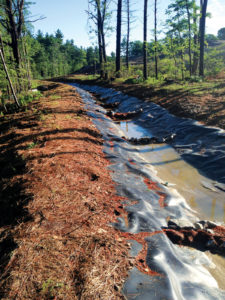
Erosion control challenges at solid waste facilities
By Eric S. Steinhauser
Introduction
Landfills, particularly municipal solid waste (MSW) landfills, are often misunderstood. Commonly referred to as “dumps,” these highly engineered facilities, and the engineering project teams involved in their development, do not get the respect they deserve. Once the primary option for MSW disposal, the modern state-of-the-practice landfill still carries the stigma associated with poorly designed and operated predecessors that resulted in significant environmental concerns.
Landfills remain a critical component of a well-conceived solid waste management plan. These facilities must be properly sited, designed, constructed, and operated, and they must comply with stringent criteria regulated by the U.S. Environmental Protection Agency (EPA) and state/local/tribal governments. Furthermore, landfill owners/operators strive to improve their facilities, be good neighbors, and provide benefits to their host communities.
While landfills may be the least preferred waste management option, for solid waste engineers landfills are big, really big, civil/environmental/geotechnical engineering projects, the life of which can outlast an individual’s professional career. Although each landfill is unique in its location, design, permit requirements, and operations, several considerations are common to all. Of the many important design and operational considerations, stormwater management and erosion and sedimentation control are significant issues that last the full life cycle of the facility.
Engineers and regulators know the importance of managing stormwater runoff from construction sites. They actively mitigate the impact of development to the natural waterways and wetland areas through careful planning, thoughtful design, and precise construction of stormwater management features (e.g., conveyance swales, retention/detention/infiltration basins, outfalls) and erosion and sedimentation controls (e.g., silt barriers, sediment traps, soil stabilization).
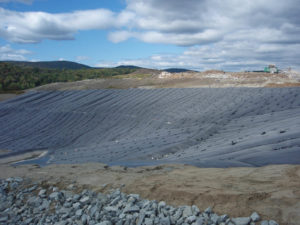
At landfills, the mitigation of stormwater-related impacts is crucial for the success of the facility. As such, mitigation techniques are considered not only for the initial construction of the facility, but for each subsequent development phase and for the long-term plan (post-closure use) of the facility. The challenge, therefore, is to cost-effectively develop a phased approach to these long-term earthwork projects that meets regulatory and operational requirements. As you can imagine, landfill development strategy can sometimes be challenging, especially when regulatory changes limit/restrict the initial development plans made years earlier.
What makes landfills so special?
Landfills are complex, highly regulated, and controversial facilities. For each project, landfill engineers, owners, and operators are challenged by the complexities of the site, the breath of regulatory requirements (see Table 1), and the political nuances of the community. In many cases, there can be competing regulations and interests, and negotiations with the regulatory authorities are required. The result is a well-planned and operated facility that can provide economic benefits, wildlife habitats, and public recreation opportunities.
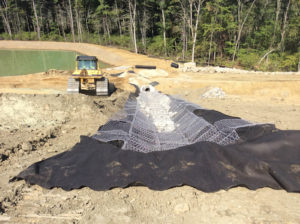
If we just consider the development aspect of a landfill project, we can make the oversimplification that landfills are just large earthwork projects, not unlike typical residential and commercial developments we see every day. However, this oversimplification collapses when we consider that the landfill “development” continues for decades and the landscape of the site continually changes. Specifically, until a landfill achieves its final configuration, the topography of the site changes as waste is placed. The longevity of the project and the ever-changing landscape requires engineers and site operators to be innovative in planning, design, and operation.
The end, or post-closure use, of a landfill site is often a topic of interest. What happens to the site after the landfill reaches its capacity and is closed? Can these facilities be an asset to the community? To the extent possible, post-closure use planning begins with the initial landfill design concept.
Because of the significant amount of time between project inception and post-closure, the end use of the site may change in part because of changes to the surrounding area and in part because of social and economic drivers. In each instance, the selected post-closure use of a landfill is intended to have a positive impact on the surrounding area. There are numerous cases in the literature of landfill sites that are now used as recreational parks, sports field, or, more recently, a solar farm. In each case, the ultimate management of stormwater at the site can be different than initially conceived when the landfill project was first planned and developed.
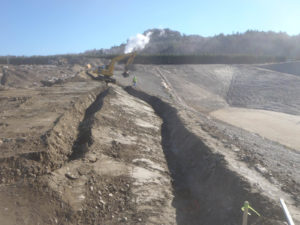
Using geosynthetics during landfill development
Like most site development projects, the management of stormwater and the need to limit the potential for erosion and sedimentation at landfills is an important consideration. Site designs are required to include an erosion control plan for construction, especially projects in which one or more acres of land is disturbed, and a stormwater management plan is needed for the completed project. For landfill projects, there may be several versions of these documents throughout the facility’s life cycle to reflect changes to site operations and regulations or to incorporate new technologies and methodologies.
The erosion and sediment control plans identify technologies (and their locations) that are specifically selected to limit the potential for soil erosion and the transport of sediment from the site for each development phase. Because landfills are dynamic development projects, the potential for erosion will change with each development phase and the locations where controls must be placed include not only the disturbed ground around the disposal area, but the daily, intermediate, and final cover soils that are placed to cover the waste mass, as well.
The use of geosynthetic materials in landfill construction and closure is well known and well documented. Numerous technical papers and textbooks address the design of landfills. These publications address: (1) geomembranes as barriers to liquids and landfill gas; (2) drainage geocomposites as conveyance media for leachate, landfill gas, and percolation water (from landfill cover systems); (3) geogrids and high-strength geotextiles for liner foundation, support, and disposal capacity optimization (e.g., mechanically stabilized berms/walls); and (4) geotextiles for puncture protection of geomembrane and separation of soil materials. These same geosynthetic materials also can be used as, or as part of, effective sediment and erosion control features.
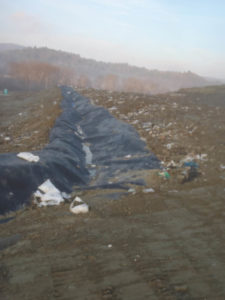
Geomembranes as alternative daily and intermediate cover material
The active filling area of a landfill is not stabilized until its final grade is reached or until filling in a defined area can be delayed for a period of time, possibly years. In these areas where landfill operational activity has been curtailed, the exposed waste needs to be covered. Most landfills are required to apply at least 6in. of soil as daily cover, and at least 12in. of soil for intermediate cover.
There is a long list of potential alternatives to soil as a cover material, and some facilities are permitted to use a nonsoil-based cover material such as a resin-based surface coating or a geomembrane.
For daily cover, reusable geomembrane tarps are used to cover the landfill working face at the end of each day. While this “impermeable” cover helps keep out precipitation and control odors and fugitive emissions, it requires special equipment to deploy and retract and can be labor intensive to deploy, especially on windy days. In addition, there are non-reusable tarps on the market that may be applicable to some sites where it is OK to leave the tarp in place with the expectation that subsequent filling will damage the tarp to the extent that it will not hinder leachate drainage. For longer-term waste cover applications (i.e., intermediate cover), exposed geomembranes made of polyethylene or polypropylene have been successful in numerous locations and in varying climates.
Geomembranes to protect constructed liner systems
A great deal of attention is paid to ensure that the landfill liner system remains intact between the time construction is complete and when waste is placed to cover the exposed leachate drainage layer. Because the drainage layer is comprised of a drainage aggregate (coarse sand of small gravel), the exposed material, especially on long side slopes, is subject to erosion. To protect against erosion, geomembrane tarps are deployed to protect the leachate collection media and removed as needed to allow for waste disposal.
Geosynthetics in interim and long-term stormwater management
As a landfill is developed and its sideslopes increase in inclination and height, stormwater runoff on the waste mass needs to be controlled so erosion rills and the resulting transportation of sediment can be limited. In these situations, landfill designs and operating plans include sideslope and downslope drainage features.
For this type of application, geosynthetics can be used to line the conveyance features to protect the underlying soil from erosion and limit waste exposure. Geomembranes have been successfully used to line interim sideslope conveyance channels and temporary and permanent downchutes. For permanent installations, geotextiles or drainage geocomposites have been used beneath the aggregate armoring of conveyance channels.
Geosynthetics for post-closure uses
Landfill post-closure uses include passive and active recreation as well as energy production. Active recreation activities, such as sports fields, can be damaging to the soil components of the landfill cover system and can increase the potential for erosion.
Artificial turf materials, which are combined with traditional geosynthetic cover system components, provide a non-erosion surface that resembles lush green grass. These products may be more expensive to construct, but can reduce site maintenance costs over the post-closure care period of the landfill (typically 30 years).
Closing thoughts
The use of geosynthetics (in particular, geomembranes) in place of soil materials in stormwater management features requires additional considerations with respect to the overall management of stormwater at the landfill facility. Exposed geomembranes will increase the amount of stormwater runoff and decrease the time between the beginning of a precipitation event and the peak runoff. This significant change to the hydrology will require modifications to the existing conveyance, detention/retention, and outfall structures. Site designers should carefully consider the potential impacts of substituting materials through hydrologic modeling. Modifications to existing site infrastructure or revisions to proposed infrastructure may be required to avoid downstream impacts.
Eric S. Steinhauser, P.E., CPESC, CPSWQ, is vice president and senior project director at Sanborn, Head & Associates Inc., Concord, N.H.
 TEXTILES.ORG
TEXTILES.ORG


